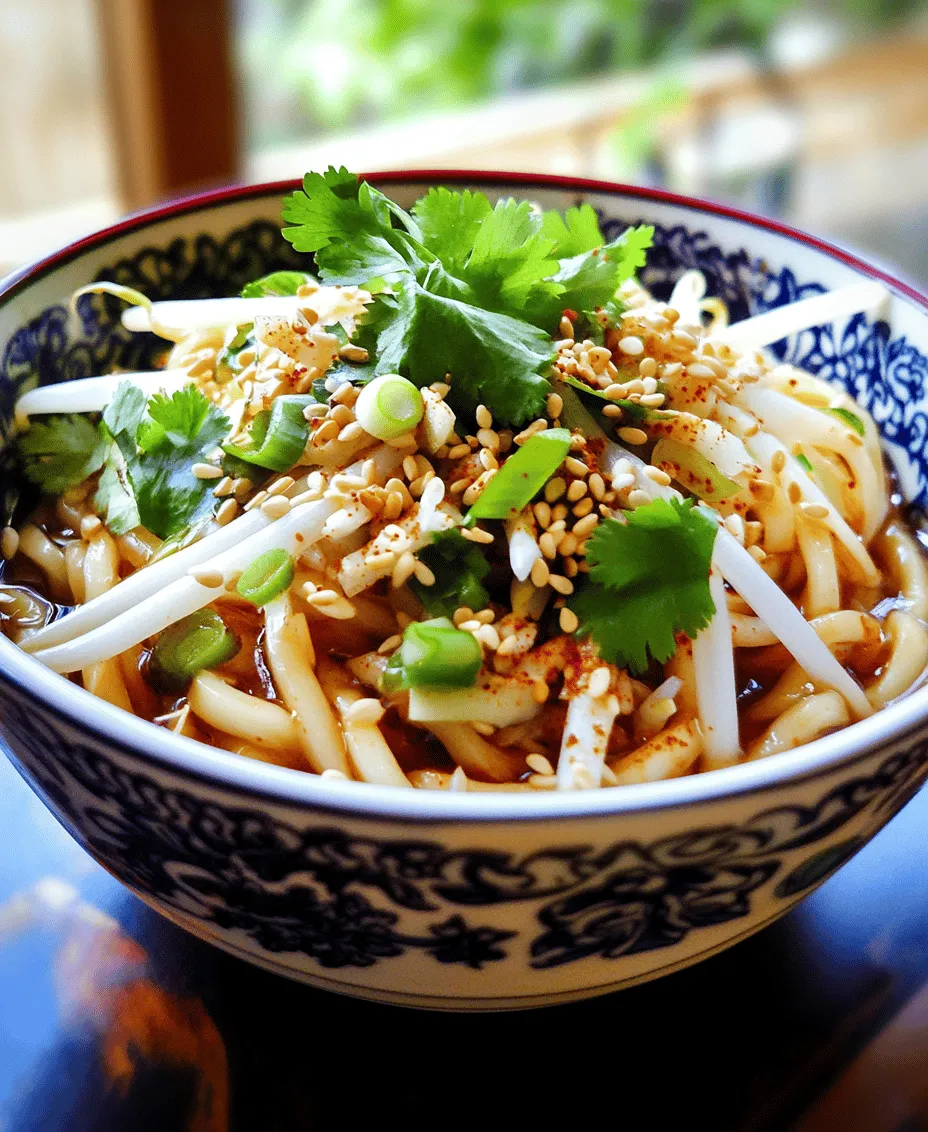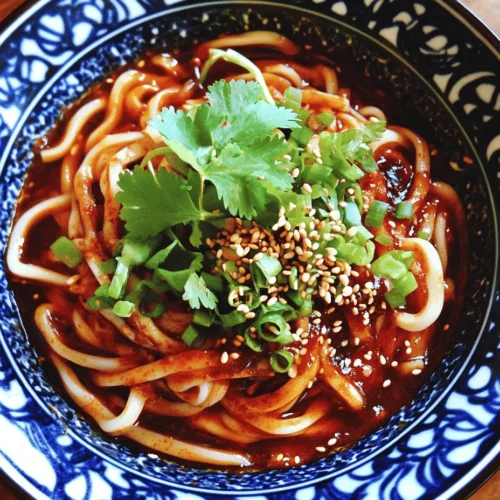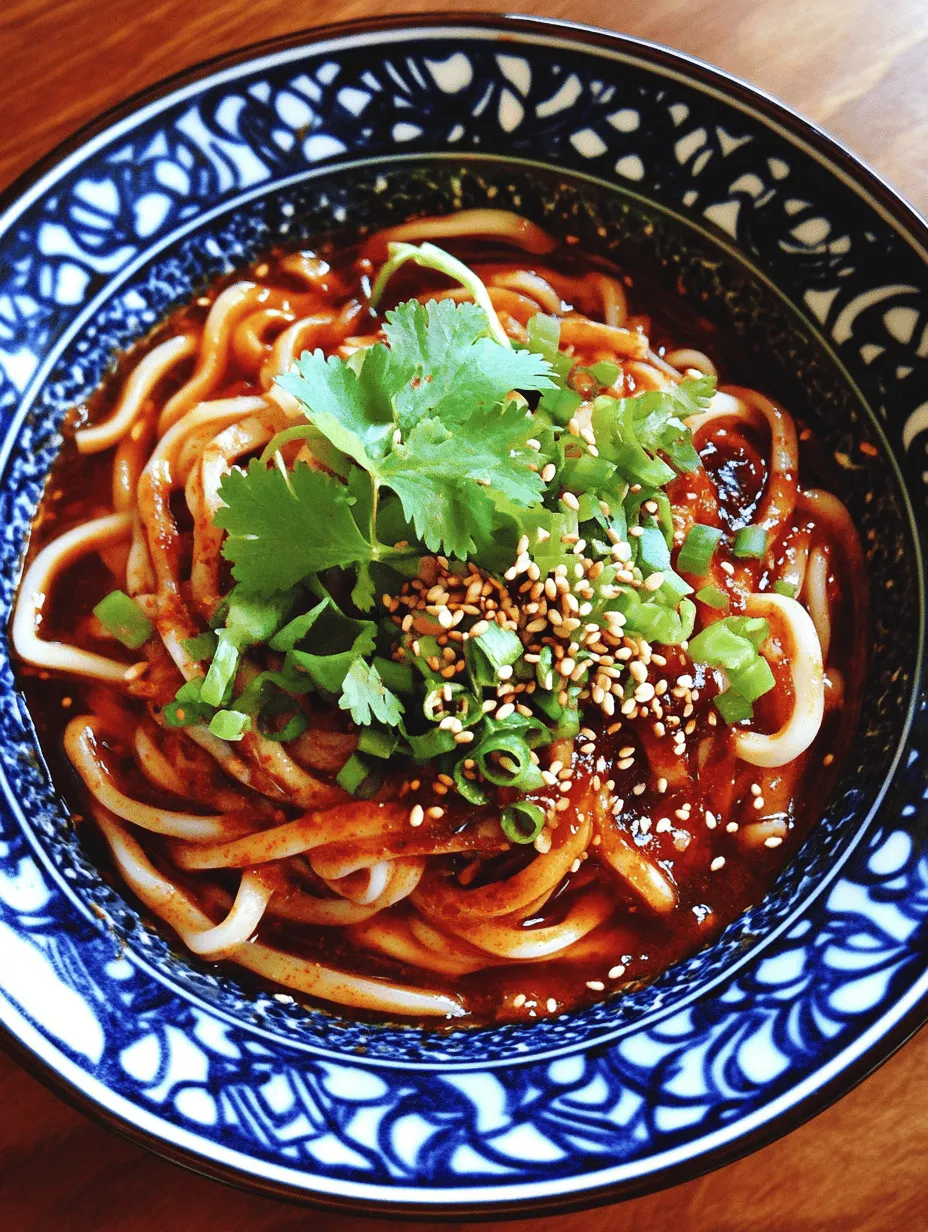Introduction
In the bustling world of quick meals, Spicy 10-Minute Chili Oil Udon Noodles stand out as a delicious and satisfying option. This dish combines the heartiness of udon noodles with a burst of flavor from a rich, spicy sauce, making it a perfect choice for lunch or dinner. With just a handful of ingredients and minimal cooking time, this recipe is not only easy to follow but also incredibly versatile. Whether you’re a busy professional seeking a quick meal or a culinary enthusiast looking to whip up something special, these udon noodles will surely impress.
Udon noodles, known for their thick, chewy texture, serve as the ideal base for this dish, readily absorbing the robust flavors of the accompanying sauces and spices. The beauty of this recipe lies in its simplicity – you can prepare it in just 10 minutes, making it an excellent option for those nights when you crave something flavorful but don’t have the time for extensive cooking. Moreover, the recipe encourages customization, allowing you to add your favorite ingredients or adjust the spice level according to your preference.
Understanding Udon Noodles
Exploring the Origins of Udon Noodles
Udon noodles boast a rich history that dates back to at least the 9th century in Japan. They are believed to have originated from Chinese wheat noodles, evolving into the thick, chewy noodles we know today. Over the centuries, udon has become a staple in Japanese cuisine, celebrated for its versatility and ability to pair well with various ingredients and flavors. Traditionally, udon is served in a simple broth, but modern variations have embraced a myriad of sauces and toppings, making it a favorite among many food lovers.
The cultural significance of udon extends beyond mere sustenance; it represents comfort food in Japan. Families often enjoy udon together, and it is commonly found in casual dining settings as well as high-end restaurants. As such, udon noodles are not just a meal; they are a part of a culinary tradition that highlights the importance of togetherness and shared experiences.
Differences Between Udon and Other Noodle Types
When comparing udon to other types of noodles, such as soba or ramen, several distinct characteristics set them apart. Udon noodles are made from wheat flour, water, and salt, giving them their signature thick and chewy texture. In contrast, soba noodles are made from buckwheat flour, resulting in a nuttier flavor and a thinner, more delicate texture. Ramen noodles, on the other hand, are often made with alkaline water, which gives them a slightly springy bite and a unique flavor profile.
One of the most appealing aspects of udon is its adaptability; it can be served hot or cold, in broth or as a stir-fry, and can be enhanced with various sauces and toppings. This flexibility makes udon a favorite among home cooks and restaurant chefs alike, allowing for endless creativity in the kitchen.
The Characteristics of Fresh Udon Noodles
Fresh udon noodles are the star of this spicy dish, delivering a delightfully chewy texture that complements the bold flavors of the chili oil and sauces. When cooked correctly, udon noodles have a satisfying bite that makes each mouthful an enjoyable experience. The freshness of the noodles plays a significant role in the overall success of the dish, as dried udon may not provide the same level of texture or flavor.
From a nutritional perspective, udon noodles offer several benefits. They are a good source of carbohydrates, providing energy and helping to keep you satiated. Additionally, udon can be a low-fat option, especially when paired with plenty of vegetables and lean protein. This makes it an excellent choice for anyone seeking a balanced meal that doesn’t compromise on taste.
Ingredients Breakdown
Essential Ingredients and Their Roles
To create the perfect bowl of Spicy 10-Minute Chili Oil Udon Noodles, you will need a few essential ingredients, each playing a crucial role in building flavor and texture.
– Fresh Udon Noodles: The foundation of this dish, fresh udon noodles provide the necessary chewiness and absorb the bold flavors of the sauce beautifully. You can find these noodles in the refrigerated section of most grocery stores or Asian markets.
– Chili Oil: This is where the heat comes from! There are various types of chili oil, from mild to extremely spicy, so it’s essential to choose one that suits your taste. For a more complex flavor, consider using a chili oil infused with spices and aromatics.
– Soy Sauce and Oyster Sauce: These sauces work together to create a savory depth of flavor. Soy sauce adds umami and saltiness, while oyster sauce contributes sweetness and richness, balancing the overall profile of the dish.
– Garlic: An aromatic foundation for many dishes, garlic brings a fragrant and slightly pungent flavor that enhances the overall taste of the noodles.
– Sesame Oil: A little goes a long way! Sesame oil adds depth and richness to the dish, complementing the chili oil and other sauces.
– Optional Ingredients: To elevate your udon noodles even further, consider adding bean sprouts for crunch, green onions for freshness, or even a soft-boiled egg for extra protein. These garnishes not only enhance the dish’s flavor but also add visual appeal.
Step-by-Step Cooking Instructions
Preparing the Udon Noodles
Now that you have a good understanding of the ingredients, let’s dive into the cooking process. To achieve the perfect udon noodles, follow these steps:
1. Boiling Techniques for Perfect Udon Noodles: Start by bringing a large pot of water to a rolling boil. Once the water reaches a vigorous boil, add the fresh udon noodles. Cook the noodles according to the package instructions, usually around 2 to 4 minutes, depending on the thickness of the noodles. Fresh udon noodles cook quickly, so keep an eye on them to avoid overcooking.
2. Tips for Rinsing and Cooling to Retain Texture: After the noodles have cooked, drain them in a colander and immediately rinse them under cold running water. This process stops the cooking, preventing the noodles from becoming mushy. Rinsing also helps remove excess starch, ensuring a firmer texture. Once rinsed, toss the noodles gently with a little sesame oil to prevent them from sticking together.
These initial steps lay the groundwork for a satisfying bowl of Spicy 10-Minute Chili Oil Udon Noodles. In the next section, we will delve deeper into the stir-frying process and how to bring all the flavors together to create a mouthwatering dish that is sure to become a favorite in your kitchen.

Crafting the Spicy Sauce
To create the perfect spicy sauce for your udon noodles, the mixing techniques you employ play a crucial role in achieving a well-blended and flavorful base. Start by combining your chili oil, soy sauce, sesame oil, and a splash of rice vinegar in a bowl. Use a whisk or a fork to vigorously mix these ingredients until they are completely incorporated. This ensures that the flavors meld together beautifully, allowing the heat of the chili oil to balance with the umami of the soy sauce and the tanginess of the vinegar.
Flavor adjustments are key to personalizing your dish. If you prefer a milder taste, consider reducing the amount of chili oil or adding a bit more soy sauce. Conversely, if you love the heat, feel free to add a sprinkle of red pepper flakes or a dash of hot sauce. Remember, the goal is to create a sauce that not only complements the udon noodles but also satisfies your palate. Taste the sauce as you mix, making small adjustments until you find the perfect balance of flavors.
Combining Ingredients for Maximum Flavor
Once your spicy sauce is ready, it’s time to combine it with the udon noodles for maximum flavor impact. Begin by cooking the noodles according to package instructions, usually boiling them for about 3-4 minutes. Drain the noodles, but be sure to reserve a bit of the cooking water. This starchy water can help to loosen your sauce if it becomes too thick once added to the noodles.
Now, to ensure the noodles are evenly coated in that delicious spicy sauce, proper tossing techniques are essential. In a large mixing bowl or pot, add the drained noodles along with your spicy sauce. Use tongs or chopsticks to gently toss the noodles, ensuring every strand is coated with the sauce. If the noodles seem too dry, add a tablespoon or two of the reserved cooking water to help distribute the sauce more evenly.
Incorporating vegetables into your dish not only enhances the nutritional profile but also adds texture and color. Consider adding thinly sliced bell peppers, carrots, or snap peas for a fresh crunch. These can be stir-fried briefly or added raw before tossing with the noodles. The contrast of textures between the tender noodles and crisp vegetables adds depth to your dish, making it not just a meal, but a culinary experience.
Serving Suggestions
Presentation is key when it comes to serving your Spicy 10-Minute Chili Oil Udon Noodles. Creative plating can elevate the dish from a simple meal to a restaurant-quality experience. Start by twirling the noodles into a nest shape in the center of a shallow bowl. This not only looks appealing but also makes it easier for your guests to serve themselves.
Garnishing your dish can enhance its visual appeal. Consider topping your noodles with finely chopped green onions, a sprinkle of sesame seeds, or even a few slices of fresh chili for an extra kick. A drizzle of additional chili oil can also add a glossy finish, making the dish look even more enticing.
When it comes to pairing options, think about what can complement your udon noodles for a complete meal. A simple side of steamed edamame or a fresh cucumber salad can balance the richness of the noodles. For beverages, iced green tea or a light Japanese beer pair wonderfully with the flavors of this dish. In many cultures, udon noodles are often served as part of a larger meal, so consider offering miso soup or a small portion of tempura as well.
Nutritional Information
Understanding the nutritional value of your Spicy 10-Minute Chili Oil Udon Noodles can help you appreciate the health benefits of the main ingredients. The dish is relatively low in calories, making it a great option for those watching their intake. A typical serving (about 1 cup) contains approximately 350 calories, with a balanced breakdown of macronutrients: around 10 grams of protein, 60 grams of carbohydrates, and 12 grams of fat. The addition of vegetables boosts the fiber content and provides essential vitamins and minerals.
Health benefits can also be derived from the individual ingredients. Udon noodles, made from wheat flour, provide energy and are a good source of carbohydrates. The vegetables add not only fiber but also antioxidants, which are vital for overall health. Chili oil, while spicy, contains capsaicin, known for its metabolism-boosting properties, making this dish both delicious and beneficial.
For those with dietary restrictions, making your udon noodles healthier is simple. Consider using gluten-free udon noodles made from rice flour or other alternative grains if you’re avoiding gluten. For a vegan option, ensure your soy sauce is plant-based, and you can skip the sesame oil if desired. If you’re concerned about spice levels, adjust the amount of chili oil according to your taste preferences, or even use a milder oil infused with herbs instead.
Conclusion
Spicy 10-Minute Chili Oil Udon Noodles are not just a quick meal; they are a delightful culinary experience that brings together rich flavors and satisfying textures. This dish showcases the versatility of udon noodles and the ease of creating a restaurant-quality meal at home. Perfect for those busy weeknights or spontaneous lunch cravings, this recipe promises to be a staple in your kitchen. Enjoy the vibrant flavors and the simple pleasure of a homemade meal that can be made in just 10 minutes. With its quick preparation, delightful taste, and health benefits, this dish is sure to become a favorite among family and friends.



